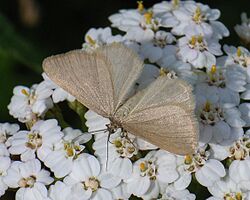Biology:Minoa murinata
From HandWiki
Short description: Species of moth
| Minoa murinata | |
|---|---|

| |
| Scientific classification | |
| Domain: | Eukaryota |
| Kingdom: | Animalia |
| Phylum: | Arthropoda |
| Class: | Insecta |
| Order: | Lepidoptera |
| Family: | Geometridae |
| Genus: | Minoa |
| Species: | M. murinata
|
| Binomial name | |
| Minoa murinata | |
| Synonyms | |
| |
Minoa murinata, the drab looper, is a moth of the family Geometridae. The species was first described by Giovanni Antonio Scopoli in his 1763 Entomologia Carniolica. It can be found in southern and central Europe, Great Britain, Anatolia, the Caucasus and the mountains of central Asia and Mongolia.
The wingspan is 14–18 mm. The length of the forewings is 9–11 mm. The moths fly from June to August depending on the location.
The larvae feed on cypress spurge and wood spurge.
Subspecies
- Minoa murinata murinata (Europe, Russia, Asia Minor, Central Asia)
- Minoa murinata amylaria Prout, 1914 (Alps, Italy)
- Minoa murinata limburgia Lempke, 1969 (Netherlands)
- Minoa murinata lutea Schwingenschuss, 1954 (Russia)[3]
References
- ↑ Yu, Dicky Sick Ki. "Minoa murinata (Scopoli 1763)". Taxapad. http://www.taxapad.com/local.php?taxonidLC=82839329.
- ↑ Brehm, Gunnar; Bodner, Florian; Strutzenberger, Patrick; Hünefeld, Frank; Fiedler, Konrad (November 1, 2011). "Neotropical Eois (Lepidoptera: Geometridae): Checklist, Biogeography, Diversity, and Description Patterns". Annals of the Entomological Society of America 104 (6). doi:10.1603/AN10050. http://www.bioone.org/doi/full/10.1603/AN10050. (Subscription content?)
- ↑ Xue, Dayong; Scoble, Malcolm J. (June 27, 2002). "A review of the genera associated with the tribe Asthenini (Lepidoptera: Geometridae: Larentiinae)". Bulletin of the Natural History Museum. Entomology Series 71 (1): 77–133. doi:10.1017/S0968045402000044. https://www.biodiversitylibrary.org/page/40870918#page/79/mode/1up.
External links
Wikidata ☰ Q1377577 entry
 |

